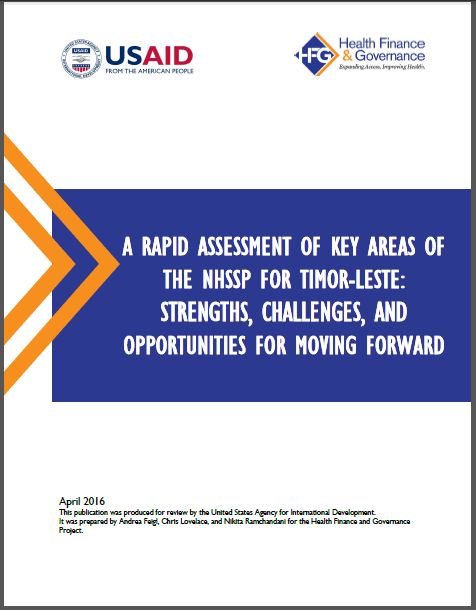A Rapid Assessment of Key Areas of the NHSSP for Timor-Leste: Strengths, Challenges, and Opportunities for Moving Forward
Categories: Health Finance, Health Systems Research, Publications
Resource Type: Report
Authors: Andrea Feigl, Chris Lovelace, Nikita Ramchandani
Published: 4/01/2016
Since gaining its independence in 2002, Timor-Leste has made significant strides in rebuilding its political system, physical infrastructure, civil service structure, and health care system. The country has done this with substantial financial and technical donor support. In the health sector, Timor-Leste has created a sound 20-year national health plan, the National Health Sector Strategic Plan (NHSSP) 2011-2030. The NHSSP identifies four health system priorities: 1) Provision of Health Services, 2) Investment in Human Capital, 3) Infrastructure Investment, and 4) Health Management and Administration.
Despite these positive developments, Timor-Leste faces significant challenges: many health indicators are poor – Timor-Leste’s stunting rate is the second highest in the world, and maternal mortality remains staggeringly high across the socio-economic spectrum. It will be important to break the cycle of close birth spacing, high fertility rates, chronic malnutrition, poor human capacity, and poor education. In addition, Timor-Leste has to take the health development agenda increasingly into its own hands, against the backdrop of dwindling donor resources and a contracting oil-dependent economy, which is responsible for up to 80 percent of Timor-Leste’s gross domestic product.
To help inform the future scope of USAID health sector support in Timor-Leste, the agency tasked the Health Finance and Governance (HFG) project with conducting a rapid assessment of Timor-Leste’s progress against the key objectives of the NHSSP, and to identify potential strategic high-impact areas for agency support.
Download




